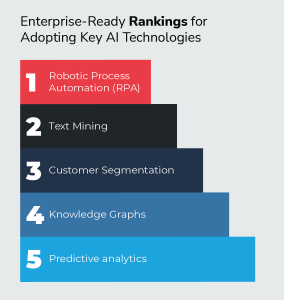Some of the biggest hurdles businesses face regarding AI adoption include the lack of valuable data, business process challenges, skill shortages, high cost of tools and resources, legal and regulatory risks, proving business value, cybersecurity, and ethics. Some AI technologies easily combat some of these issues, allowing for easier, widespread adoption, while others still need to mature before the majority of businesses can leverage them.
In our recent blog, we highlighted the key AI technologies businesses across multiple industries are leveraging to improve service delivery and optimize the customer experience. We’re taking the next step in this post, ranking these technologies in terms of readiness for adoption. Let’s get into it.
#1 Robotic Process Automation
The pandemic changed how we work and, in many cases, how businesses operate. Consequently, it has also accelerated the digital transformation process, including automation and thus RPA. According to Precedence Research, the global robotic process automation market is projected to hit around USD 23.9 billion by 2030, growing at a CAGR of 27.7% from 2021 to 2030. RPA is expected to remain the fastest-growing enterprise technology, with many predicting that it will continue to grow at a robust pace.
In addition, the RPA services market continues to be vibrant and diverse. Most major consultancies, global systems integrators, and business process outsourcers have a track record of using RPA to support cost takeout and extend their clients’ broader transformation goals.
One of the main advantages of RPA is automation at a relatively low cost and in a short time. In addition, the implementation and use of software robots are non-invasive, controlling selected infrastructure elements without interfering with existing systems.
#2 Text Mining
Text mining implementation was initially slow to gain traction. Originally, there were only loosely integrated and independent solutions available. Companies often did not quickly see the true value behind sophisticated analytical solutions. However, we’ve seen text analytics adoption rates increase, and we expect this trend to continue. According to Reports and Data, the global Text Mining Market is forecast to grow at a rate of 18.1%, from USD 4.75 Billion in 2019 to USD 16.85 Billion in 2027.
Several factors driving the market are a rise in social media analytics, an increase in industry-specific text analysis, the growing penetration of smartphone users worldwide, and the emergence of multilingual text analysis to break language barriers.
The banking, financial services, and insurance sectors have been text mining adopters. Banks increasingly use natural language processing, allowing computers to understand and respond to human language.
#3 Customer Segmentation
Segmentation has been around for quite some time, with marketing teams leveraging this technology to deliver customer personalization. However, with the ongoing changes in technology used for gathering data, new generations of consumers who require highly personalized content, and recent changes in buying behaviors caused by COVID-19, updating the methods behind data segmentation has become crucial.
We’re seeing more small and mid-sized companies joining in on the fun to start using AI customer segmentation, and for good reason. Segmented campaigns can bring up to 760% revenue growth for companies, and 77% of marketing ROI comes from segmented and targeted campaigns.
#4 Knowledge Graphs
A Knowledge Graph is a close-to-reality model that aims to represent existing entities and relationships, serving as a central knowledge platform. Knowledge Graph technology globally is experiencing accelerated momentum. Gartner, amongst other analysts, has anticipated that the application of knowledge graphs will grow at 100 percent annually through 2022 to continuously accelerate data preparation and enable more complex and adaptive data science.
Organizations need to consider and adopt graph technology to take advantage of the possible competitive advantage by being early adopters. For example, Wizeline recently built a knowledge graph to help a global media company deliver timely information to its users. See the case study here.
#5 Predictive Analytics
Predictive analytics is a branch of advanced analytics that uses historical data, statistical algorithms, and machine learning techniques to predict future outcomes. Predictive analytics is still a young and developing technology, meaning there is much more to come. As techniques, methods, tools, and technologies improve, so will the benefits to businesses.
However, this is not a technology organizations can afford to adopt later, after the tech reaches maturity and all the kinks are worked out. The near-term advantages are too substantial for a late adopter to overcome and remain competitive.
The predictive analytics market is expected to reach a notable CAGR of 24.9% in 2030. The increase in performance and reduced risks expected to be taken due to the ability to make more well-informed decisions with predictive analytics are some factors that positively affect the market.
How Can Wizeline Help?
Now that you have an idea of some of the most enterprise-ready AI technologies, it’s time to develop your implementation strategy to maximize business results.
Wizeline’s Intelligence Everywhere offering brings AI at scale, connecting core business processes with continuously growing and improving data services. We help you re-architect your data platforms and bring artificial intelligence services at scale to increase revenue, improve business efficiency, and cut down on manual processes.
For more on this topic, check out our guide to AI technologies, where we explore AI applications across major industries and discuss the key technologies driving innovation in AI. If you’d like to learn how Wizeline can help you mature your data-driven capabilities, contact us at consulting@wizeline.com.






